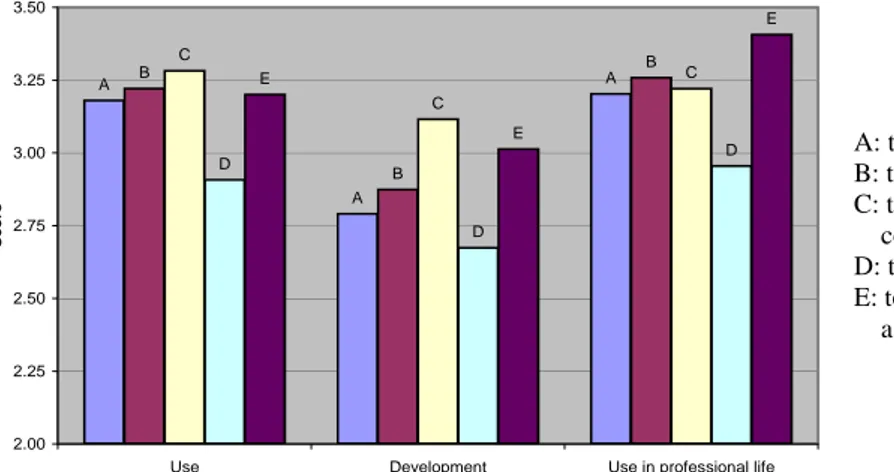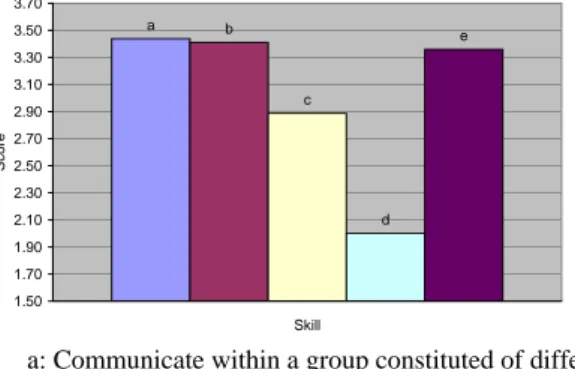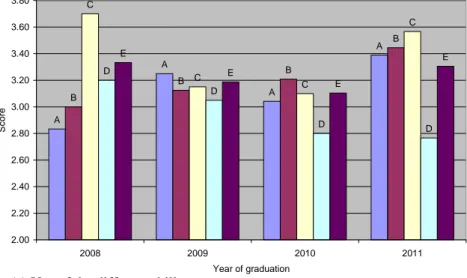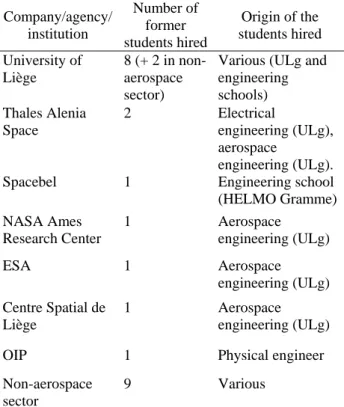IAC-11.E1.2.8
EDUCATIONAL ASSESSMENT OF FOUR YEARS OF CUBESAT ACTIVITIES AT THE UNIVERSITY OF LIÈGE,BELGIUM
Ms. Amandine Denis
Aerospace and Mechanical Engineering Dept, University of Liège, Belgium, Amandine.Denis@ulg.ac.be Mr. Jonathan Pisane, Prof. Jacques Verly,
Dept of EECS, University of Liège, Belgium, {jpisane, jacques.verly}@ulg.ac.be Prof. Gaetan Kerschen,
Aerospace and Mechanical Engineering Dept, University of Liège, Belgium, g.kerschen@ulg.ac.be
This paper presents and analyses the results of a survey assessing the educational outcomes of the OUFTI-1 project. OUFTI-1 will be the first Belgian student CubeSat. Its main payload is the use of the D-STAR radiocommunication protocol in space. The entire technical work is done by undergraduate students, and managed by academics and young engineers from the University of Liège. The main objective of OUFTI-1 is educational. It aims at providing hands-on experience to students in the design, construction, and control of a complete satellite system. This leads students to acquire scientific and technical knowledge but also to develop soft skills. These skills are the main concern of this paper. The soft skills aimed by OUFTI-1 can be grouped together in 5 fields: (A) to establish synergies between theory and practice, (B) to adopt an applied scientific approach, (C) to master written and oral scientific communication, (D) to manage a collaborative work, and (D) to manage a substantial work that should lead into a concrete result. The 40 former students of the project were submitted a survey regarding the use, the development, and the use in professional life of these skills. Students are also questioned about the influence of OUFTI-1 on their career. 24 answers were received (participation rate of 60%) and are analyzed in this paper. It is showed that the soft skills aimed by OUFTI-1 are widely used and developed within the project, and used in professional life. The use and development of communication skills is emphasised by the students, as well as the collaborative skills (with some nuances). The influence of the graduation year on the results is considered. It influences the most used skill, as this skill depends of the specificities of the work performed by each generation of students. Similarly, the most-used-in-professional-life skills depend of the seniority of the former students, as it reflects the evolution of their careers. In all cases, a good concordance is showed between the most developed and the most-important-in-professional-life competences. It also appears that OUFTI-1 has a positive influence on the professional life of former students. Most of them work in the aerospace sector.
Section I briefly presents OUFTI-1. Section II describes the different skills aimed by the project and considered in the survey. Section III introduces the survey and analyses the results. Conclusions are drawn in section IV.
I. THE OUFTI-1 PROJECT
OUFTI-1 will be the first Belgian student nanosatellite. It is being developed since 2007 at the University of Liège, Belgium, in collaboration with two engineering schools (HEPL ISIL and HELMO Gramme), a computer science school (HEPL INPRES) and the Université Catholique de Louvain, Belgium.
OUFTI-1 is a CubeSat: a cube-shaped satellite with a size of 10x10x10 cm and a weight of at most one kilogram. The key, innovative feature of OUFTI-1 is its main payload: the D-STAR digital-communication protocol. The D-STAR is a recently-developed amateur radio protocol which provides a lot of new built-in features including digital communication, simultaneous voice and data transmission (e.g., GPS
data and computer files), complete routing over the internet and callsign-based roaming on a worldwide basis. OUFTI-1 will be the first satellite to test the use of the D-STAR communication protocol in space. Another experiment that will fly aboard OUFTI-1 is an innovative electrical power system developed in collaboration with Thales Alenia Space ETCA. OUFTI-1 will also fly new high-efficiency solar cells from AzurSpace.
Beyond these technical objectives, OUFTI-1 is definitely an educational project. It aims at providing hands-on experience to students in the design, construction, and control of a complete satellite system. The various subsystems are thus developed by students during their M.S. thesis. Students come from different engineering fields: aerospace engineering, mechanics, computer science and
released to the IAF to publish in all forms.
electrical engineering. They are advised in their choices and tasks by an “advisory board" composed of professors and specialists from the industry. They can also take full advantage of the significant expertise and experience available in Liège in the space arena. Technical choices are supervised and kept coherent by a system engineering team composed of former students currently working at the university. The entire, highly multidisciplinary team is managed by a teaching assistant from the aerospace engineering department. Figure 1 shows this organization.
II.DEVELOPMENT OF SOFT SKILLS THROUGH AN EDUCATIONAL NANOSATELLITE PROJECT
The main objective of the OUFTI-1 project is labelled “education and fun”. This educational objective is twofold: students should acquire knowledge but also develop soft skills. OUFTI-1 provides them with a favourable framework to practise and develop these skills.
For students in their final year of degree, OUFTI-1 is a good opportunity to establish synergies between theory and practice. The projects encountered during their studies are often dedicated to a single course. In most of these projects, the methodology is suggested and the solution is known to exist. In the OUFTI-1 project, the problems raised are concrete, vast, and complex. Students have first to analyze and restate the problems with respect to the theory learned, and then to join the different courses in order to solve it in a concrete way. An applied scientific approach is mandatory. This means in particular to search for new information, to be critical, and to have a structured and rigorous method.
Communication skills are practised through various kinds of presentations. Students are confronted to authentic situations, by opposition to presentations in the classroom. Conferences and workshops teach students to present their work to experts, professionals, and colleagues. When conferences take place abroad, a foreign language is also practised.
Furthermore, presentations to a general audience or to younger students develop the ability to popularize technical topics. Written communication (in native or foreign language) is also practised, i.e. in reports, articles, and of course in the thesis manuscript. To work as a team is a key feature of the project. The teams encountered during the studies (i.e. in course projects) are often composed of few (2-4) students with the same background. On the opposite, the OUFTI-1 team is composed of about twelve undergraduate students with different specialities and from different institutes. Students come from two universities (University of Liège and Université Catholique de Louvain), two engineering schools (HEPL-ISIL and HELMO-Gramme), and a computer science school (HEPL-INPRES). They are students pursuing a master degree in (electronics, aerospace, physics, or computer) engineering, in computer science, or a bachelor degree in computer science. The challenge to work as a team with these different profiles has to be mastered by students. They learn to communicate with colleagues from different specialities, and to collaborate to solve multidisciplinary problems. Sharing tasks is essential, as well as taking into account the mutual consequences of choices and developments.
The applied nature of the OUFTI-1 project leads the students to develop several abilities. A concrete result is expected and deadlines have to be respected, therefore the students have to carefully plan their work. Moreover, schedules of the different students (and thus for the different subsystems) have to be coherent, and possibly adapted along the year. Students are given responsibilities, so they have to be autonomous and take initiatives in their work. This includes contacting suppliers, manufacturers, and experts from companies or research centers. It is also necessary to be critical and practical regarding the envisioned solutions, as they will be implemented on a flight-model.
III.SURVEY ASSESSING THE EDUCATIONAL OUTCOMES OF THE OUFTI-1 PROJECT
Fig. 1: Organization of the OUFTI-1 team.
Since the beginning of the project in 2007, 40 students were involved in OUFTI-1. They make up an interesting panel to question about the educational outcomes of the project, and especially about the soft skills used and developed during their participation in OUFTI-1. The 40 students can be divided in 4 different teams, each corresponding to an academic year. Table 1 shows the number of students for each of the 4 years.
III.I. Content of the survey
The 40 students were submitted a two-part survey. The first part lists 22 soft skills. For each of them, students are asked how much the skill was used and developed in the framework of OUFTI-1. The students graduated since more than one year are also asked how much each of the mentioned skills is used in their professional life. These three evaluations (use in OUFTI-1, development, use in professional life) are performed by the mean of a number between 1 (very weekly) to 4 (strongly). The 22 soft skills are grouped together in 5 fields: (A) to establish synergies between theory and practice, (B) to adopt an applied scientific approach, (C) to master written and oral scientific communication, (D) to manage a collaborative work, and (D) to manage a substantial work that should lead into a concrete result.
The second part of the survey asks open questions. First, students are asked which are the (only one)
most developed skill, as well as the (only one) most important for their professional life. Then they are asked if they currently work in aerospace sector and for which company. Finally, students are asked if the OUFTI-1 project was mentioned in their job interviews, influenced their recruitment, and if it prepared them for the professional world.
III.II. Analysis of the results Received answers
24 answers were received, out of 40 former students pooled. This gives a participation rate of 60%, which confers a high representativeness on the results presented and analysed below. Moreover, Table 1 shows that more than 50% of each team answered to the survey. The results are therefore representative of every generation of students.
Analysis of the answers to the closed questions The particular scores given by students are averaged to obtain a global score for each competence. These averaged scores are analyzed below and simply named “scores”. They are also averaged by domain of skills (as defined above) and/or averaged distinctively for each generation of students.
Figure 2 shows the scores of the different domains of soft skills for the (1) ‘use’, (2) ‘development’, and (3) ‘use in professional life’ questions. The most used domain of soft skills is “to master written and oral scientific communication”, closely followed by three domains: “to adopt an applied scientific approach”, “to manage a substantial work that should lead into a concrete result”, and “to establish synergies between theory and practice” (in order of scores). “To manage a collaborative work” is surprisingly the least used domain of skills. Looking closer at the different abilities of this domain can explain this low score.
Academic year Number of students Number of answers Participation rate 2007-2008 2 2 100% 2008-2009 13 8 61.5% 2009-2010 15 8 53.3% 2010-2011 10 6 60% Total 40 24 60%
Table 1: Number of students and participation rate according to the academic year.
A A A B B B C C C D D D E E E 2.00 2.25 2.50 2.75 3.00 3.25 3.50
Use Development Use in professional life
Scor
e
Fig. 2: Scores of the different domains of soft skills for the (1) ‘use’, (2) ‘development’, and (3) ‘use in professional life’ questions.
A: to establish synergies between theory and practice B: to adopt an applied scientific approach
C: to master written and oral scientific communication
D: to manage a collaborative work
E: to manage a substantial work that should lead into a concrete result
released to the IAF to publish in all forms.
Figure 3 shows the detailed scores for the collaborative skills. Two of them have a score under the mean of 3.16 (mean of all the scores for the “use” question) while the other three are clearly above. “To communicate within a group constituted of different profiles” is even one of the most used skills. On the contrary, “manage the possible tensions rising within the group” and “to share tasks” obtain relatively low scores. Potential explanations are respectively that few tensions arose within the teams, and that most of the tasks were already shared between students by the management of the project.
The ranking of the developed domains of skills is similar, except for the 3rd and 4th that are inverted. Communication abilities come first. These abilities are indeed poorly exercised during the studies. OUFTI-1 provides unique opportunities in this domain, such as conferences or presentations to the general public. Students are encouraged to perform these presentations and are well trained in this purpose. Again, the collaborative skills come in the last position. The same explanations as above can be made.
A significant difference can be observed in the ranking of the abilities used in the professional life. The first ranked domain is “to manage a substantial work that should lead into a concrete result”. Three of its abilities obtain the highest score for this question: “to plan one’s work”, “to take initiative”, and “to be autonomous”. “To be critical” obtains the same highest score. This ability is part of the second ranked domain, namely “to adopt an applied scientific approach”. It is closely followed by the communication skills and the domain regarding the
theory-practice synergies. Again the collaborative skills come last.
It is interesting to observe this last ranking (‘use in professional life’) separately for each of the teams. Figure 4 shows the evolution of the score of each domain of skills according to the length of the students’ professional life. Communication and collaborative skills are more and more declared to be used according to the seniority. On the contrary, skills closer to the studies (i.e. theory-practice synergies and scientific approach) seem less and less used in time. This reflects the evolution of the careers of the former students. They probably tend to have more responsibilities (and thus manage a team or deliver presentations) as their career evolves.
Figure 5a shows the use of the different skills according to the year of graduation. It reflects the specificities of the work performed by each generation of students. The first team (graduated in 2008) was deeply involved in the presentation of OUFTI-1 to ESA (in order to be selected for the Vega maiden flight). Communication skills were therefore intensively used. The second team (graduated in 2009) was in charge of the preliminary design. Numerous links between theory and practice were therefore necessary to provide solid bases to the nanosatellite. Team 3 (graduated in 2010) refined the first design. A scientific and structured approach was thus needed to move from a preliminary to a detailed design. The last team (graduated in 2011) gives the
A: to establish synergies between theory and practice B: to adopt an applied scientific approach
C: to master written and oral scientific communication D: to manage a collaborative work
E: to manage a substantial work that should lead into a concrete result
Fig. 4: Evolution of the “use in professional life” score of each domain of skills according to the length of the students’ professional life.
A B C D E 2.00 2.20 2.40 2.60 2.80 3.00 3.20 3.40 3.60 3.80 4.00 1 2 3
Lenght of students' professional life (years)
Score
Fig. 3: Detailed scores for the use of collaborative skills.
a: Communicate within a group constituted of different profiles
b: Collaborate to solve consequent and multidisciplinary problems
c: Share tasks
d: Manage the possible tensions rising within the group e: Take into account the mutual consequences of choices and developments
a b c d e 1.50 1.70 1.90 2.10 2.30 2.50 2.70 2.90 3.10 3.30 3.50 3.70 Skill Sc ore
A A A A B B B B C C D D D D E E E E 2.00 2.20 2.40 2.60 2.80 3.00 3.20 3.40 2008 2009 2010 2011 Year of graduation Sc o re A A A A B B B B C C C C D D D D E E E E 2.40 2.60 2.80 3.00 3.20 3.40 3.60 3.80 4.00 2008 2009 2010 2011 Year of graduation Sc ore
A: to establish synergies between theory and practice
B: to adopt an applied scientific approach
C: to master written and oral scientific communication
D: to manage a collaborative work E: to manage a substantial work that
should lead into a concrete result
Fig. 5: Use and development of the different skills according to the year of graduation. (a) Use of the different skills.
(b) Development of the different skills.
highest score to the communication skills, especially for the “to write in English” competence. This can be explained by the design review held this year, for which students were asked to write technical documentation in English. Figure 5b shows that students unanimously recognize the development of communication skills, whatever their year of graduation.
Finally, it can be noticed that all the domains of skills obtain a score higher than the average of 2.5. It is also true for every single skill (with the exception of “to share tasks” and “to manage the possible tensions”, as already analysed above). The soft skills aimed by OUFTI-1 are thus used and developed within the project, and used in professional life.
Analysis of the answers to the open questions When questioned about the (only one) most developed ability, students name first the collaborative skills. It confirms our above assumption about the weak score of this domain: collaborative skills are widely used and developed, but not each of the skills proposed. Communication skills are the second most developed abilities, closely followed by autonomy and scheduling skills. Communication and collaborative skills are also the top-2 most important skills for the professional life, according to students. This good concordance between most developed and most important competences is worth to be noticed.
released to the IAF to publish in all forms.
OUFTI-1 was mentioned in the job interview of nearly 71% of the former students. These students name only positive consequences. Recruiters were interested by the team work, the experience gained, and the abilities developed thanks to the project. In two cases, students went in contact with the company during their thesis and finally hired.
IV.CONCLUSION
OUFTI-1 will be the first Belgian student CubeSat. The entire technical work is done by undergraduate students, as the main objective of OUFTI-1 is educational. It aims at providing hands-on experience to students in the design, construction, and control of a complete satellite system. This leads students to acquire scientific and technical knowledge but also to develop soft skills. The soft skills aimed by OUFTI-1 can be grouped together in 5 fields: (A) to establish synergies between theory and practice, (B) to adopt an applied scientific approach, (C) to master written and oral scientific communication, (D) to manage a collaborative work, and (D) to manage a substantial work that should lead into a concrete result. The 40 former students of the project were submitted a survey regarding the use, the development, and the use in professional life of these skills. Students are also questioned about the influence of OUFTI-1 on their career. 24 answers were received (participation rate of 60%) and analyzed in this paper.
19 students out of 24 (i.e. 79%) think that OUFTI-1 prepared them to their professional life. No negative answer is given and the 5 abstentions are mainly students pursuing a PhD thesis. Amongst the 19 positive answers, one of the most named reasons is the concrete nature of the project. After 4 years of mainly theoretical studies, the applied nature of the project is appreciated by students and constitutes a good transition towards the professional life. The team work is the second most named reason. Some nuances are also mentioned. OUFTI-1 does not prepare students to the hierarchical aspects of the professional life, and constraints are much stronger in a company.
Table 2 shows the current employer of the former students. 62.5% of the students (who answered the survey) currently work in the aerospace sector in companies or agencies such as Thales Alenia Space, Spacebel, ESA, or NASA Ames Research Center. 10 of the 40 former students are still at the University of Liège (all of them answered the survey), either as a research engineer or as a PhD candidate.
A major conclusion is that the soft skills aimed by OUFTI-1 are widely used and developed within the project, and used in professional life. The use and development of communication skills is emphasised by the students, as well as the collaborative skills. Some nuances were mentioned regarding the latter field. The influence of the graduation year on the results was also considered. It influences the most used skill, as this skill depends of the specificities of the work performed by each generation of students. Similarly, the most-used-in-professional-life skills depend of the seniority of the former students, as it reflects the evolution of their careers. In all cases, a good concordance is showed between the most developed and the most important in professional life competences. It also appears that OUFTI-1 has a positive influence on the professional life of former students. OUFTI-1 was mentioned in most of the job interviews. Students consider the project as a good transition towards the professional life. Most of them work in the aerospace sector, at the University of Liège or in companies and agencies such as Thales Alenia Space, Spacebel, ESA, or NASA Ames Research Center.
These results are encouraging and positive regarding the philosophy of the project. It is important to deeply involve students in every aspect of the project, so they develop soft skills useful for their future professional life. The conclusions also confirm the interest to develop new educational satellite projects after the launch of OUFTI-1 (scheduled for 2012). Company/agency/ institution Number of former students hired Origin of the students hired University of Liège 8 (+ 2 in non-aerospace sector)
Various (ULg and engineering schools) Thales Alenia Space 2 Electrical engineering (ULg), aerospace engineering (ULg).
Spacebel 1 Engineering school
(HELMO Gramme) NASA Ames Research Center 1 Aerospace engineering (ULg) ESA 1 Aerospace engineering (ULg) Centre Spatial de Liège 1 Aerospace engineering (ULg)
OIP 1 Physical engineer
Non-aerospace sector
9 Various Table 2: current employers of former students.




